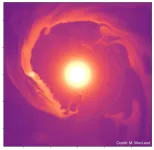(Press-News.org) A planet about 950 light years from Earth could be the Looney Tunes’ Yosemite Sam equivalent of planets, blowing its atmospheric ‘top’ in spectacular fashion.
The planet called HAT-P-32b is losing so much of its atmospheric helium that the trailing gas tails are among the largest structures yet known of an exoplanet, a planet outside our solar system, according to observations by astronomers.
Three-dimensional (3D) simulations on the Stampede2 supercomputer of the Texas Advanced Computing Center (TACC) helped model the flow of the planet’s atmosphere, based on data from the Hobby-Eberly Telescope of The University of Texas at Austin's McDonald Observatory. The scientists hope to widen their planet-observing net and survey 20 additional star systems to find more planets losing their atmosphere and learn about their evolution.
“We have monitored this planet and the host star with long time series spectroscopy, observations made of the star and planet over a couple of nights. And what we found is there's a gigantic helium gas tail that is associated with the planet. The tail is large — about 53 times the planet’s radius — formed by gas that’s escaping from the planet,” said Zhoujian Zhang, a postdoctoral fellow in the Department of Astronomy & Astrophysics, University of California Santa Cruz.
Zhang is the lead author in a study on the helium tail detected from HAT-P 32b that was published in Science Advances June 2023. The science team used data from the Habitable Planet Finder spectrograph, an instrument on the Hobby-Eberly telescope, which provides high spectral resolution of light in near infrared wavelengths.
The planet HAT-P-32b was discovered in 2011 using spectroscopic data from the Hungarian-made Automated Telescope Network. It’s known as a ‘hot Jupiter,’ a gas giant similar to our neighboring planet Jupiter, but with a radius twice as large. This hot Jupiter hugs closely in orbit to its host star, about three percent the distance from the Earth to the Sun. Its orbital period — what we consider a year here on Earth — is only 2.15 days, and this proximity to the star scorches it with both long and short wave radiation.
The main motivation for the scientists’ interest in studying hot Jupiters is their pursuit of the mystery of the Neptunian desert, the inexplicable relative scarcity on average of intermediate-mass planets, or sub-Jupiters, with short orbital periods.
“One of the potential explanations is that maybe the planets are losing their mass,” Zhang offered. “If we can capture planets in the process of losing their atmosphere, then we can study how fast the planet is losing their mass and what are the mechanisms that cause their atmosphere to escape from the planet. It's good to have some examples to see like the HAT-P-32b process in action.”
The light analyzed in the study comes from the star HAT-P-32 A. It’s slightly hotter and similar in size to our own sun. The analyzed light is not just straight starlight. As the planet passes in front of the star, for just a couple of hours the starlight gets filtered the most by the planet’s gassy atmosphere. This filtering, called absorption, reveals features of the transiting planet, in this case huge outflows of helium when the spectra were analyzed.
Zhang and colleagues used a technique called transmission spectroscopy to separate the starlight into its component frequencies, like a prism separates sunlight into a rainbow spectrum. Gaps in the spectrum indicate light being absorbed by elements in the gaseous atmosphere of HAT-P-32b.
“What we see in our data is that when the planet is transiting the star, we see there's deeper helium absorption lines. The helium absorption is stronger than what we expect from the stellar atmosphere. This excess helium absorption should be caused by the planet’s atmosphere. When the planet is transiting, its atmosphere is so huge that it blocks part of the atmosphere that absorbs the helium line, and that causes this excess absorption. That's how we discovered the HAT-P-32b to be an interesting planet,” Zhang said.
It got more interesting as they developed 3D hydrodynamical simulations of the HAT-P-32b and host star, led by Antonija Oklopčić, Anton Pannekoek Institute for Astronomy, University of Amsterdam; and Morgan MacLeod, Institute for Theory and Computation, Harvard-Smithsonian Center for Astrophysics, Harvard University.
The models examined the interactions between the planetary outflow and stellar winds in the tidal gravitational field of the extrasolar system. The models showed columnar tails of planetary outflow both leading and trailing the planet along its orbital path with excess helium absorption even far from the transit points that matched observations. What is more, the models suggest complete loss of the atmosphere in about 4 x 10e10 Earth years.
“We made use of TACC's Stampede2 system's Intel Skylake nodes for our calculations,” MacLeod said. “This computation involves tracking flow as it accelerates from a slow-moving subsonic 'atmosphere' near the planet to a supersonic wind as it moves further away. The HAT-P-32b system was identified to have a large-scale outflow similar in size to the planet's orbit around the star. Taken together, these requirements suggest the need for a stable, high-accuracy algorithm for solving three-dimensional gas dynamics.”
The modelers utilized the Athena++ hydrodynamic software and a custom problem setup to do their calculation on Stampede2. With it they solve the equations of gas dynamics in a rotating frame of reference that matches the planet's orbital motion. Athena++ is a Eulerian code -- the flow is discretized with volume elements -- and they used nested layers of mesh refinement to capture the large-scale star-planet system along with the much smaller scale of the atmosphere near the planet's surface.
“Using the TACC HPC systems is a joy,” MacLeod said. “A few things go into this -- the first, and most important is the level of support. Whenever I have a problem, I can call the support line, get help, and get back to doing the science that I am best at. Secondly, the vast majority of my time goes into developing and validating model results, rather than running a single, full-scale calculation. The TACC systems are incredibly well set up for this reality, and it hugely speeds up the pace of development. Being able to run test calculations through the development queues or submit larger calculations of a range of sizes in the lead up to an eventual final model is crucial and effective in these environments.”
Looking ahead, the scientists hope to continue to develop sophisticated 3D models that capture effects such as atmospheric mixing of gases and even winds within the atmosphere on more distant worlds hundreds and even thousands of light years away.
“Now is the time to have supercomputers with the computational power to make this happen," Zhang said. "We need the computers to make real predictions based on recent advances in the theory and to explain the data. Supercomputers bridge the model and the data."
“The best thing we can do is watch the night sky and try to recreate what we see through computer modeling," MacLeod concluded. "Our universe is complicated. This means we need to have access to the absolute best supercomputing systems."
The study, Giant tidal tails of helium escaping the hot Jupiter HAT- P-32 b, was published June 7, 2023, in the journal Science Advances. The study authors are Zhoujian Zhang of UCSC; Caroline V. Morley, Michael Gully-Santiago, Jessica Luna, Quang H. Tran, Daniel M. Krolikowski, William D. Cochran, Brendan P. Bowler, Michael Endl, Gudmundur Stefánsson, Benjamin M. Tofflemire, Gregory R. Zeimann of UT Austin; Morgan MacLeod of Harvard University; Antonija Oklopčić of University of Amsterdam; Joe P. Ninan of Tata Institute of Fundamental Research; Suvrath Mahadevan of The Pennsylvania State University; Andrew Vanderburg of MIT. Funding came from the NASA Exoplanets Research Program grant number 80NSSC20K0257; National Science Foundation grant 2108801; NASA Hubble Fellowship grants HST-HF2- 51522.001-A. Support also came from NSF grants AST-1006676, AST-1126413, AST-1310875, AST-1310885, AST 2009889, AST 2009982, ATI 2009955, and AAG 2108512 and the Heising-Simons Foundation via grant 2017- 0494.
END
Hot Jupiter blows its top
Stampede2 simulations help capture helium gas clouds escaping distant planet
2023-09-01
ELSE PRESS RELEASES FROM THIS DATE:
Kidder receives American Chemical Society’s 2023 Mid-Career Award
2023-09-01
Michelle Kidder, a senior R&D staff scientist at the Department of Energy’s Oak Ridge National Laboratory, has received the American Chemical Society’s Energy and Fuels Division’s Mid-Career Award for sustained and distinguished contributions to the field of energy and fuel chemistry. She was recognized for her scientific community service, leadership and contributions. Her research focuses on novel material development, methods and advanced characterizations for the separation and reaction chemistry of renewable energy resources including lignin and carbon dioxide.
Kidder, ...
Mukherjee elevated to senior member of IEEE
2023-09-01
Subho Mukherjee, an R&D associate in the Vehicle Power Electronics Research group at the Department of Energy’s Oak Ridge National Laboratory, has been elevated to the grade of senior member of the Institute of Electrical and Electronics Engineers, or IEEE. Senior IEEE members have made significant contributions to the profession and worked in the engineering field for 10 years or more.
As an electrical engineer, Mukherjee focuses on wireless power charging and developing wide bandgap semiconductor-based ...
SMART-BARN – a cutting-edge technology lab to study animal groups
2023-09-01
Researchers from the Cluster of Excellence Centre for the Advanced Study of Collective Behaviour (CASCB) and the Max Planck Institute of Animal Behavior have converted a former barn into a cutting-edge technology lab for complex behavioral analysis. In it, they can now study the intricate behaviour of animal groups. The barn also served as a prototype for the largest swarm behaviour lab at the University of Konstanz: the Imaging Hangar.
A major limitation in behavioural research is that scientists can either study animals under highly-controlled, yet often unrealistically simplified and ...
Immune cells shape their own path
2023-09-01
When fighting disease, our immune cells need to reach their target quickly. Researchers at the Institute of Science and Technology Austria (ISTA) now discovered that immune cells actively generate their own guidance system to navigate through complex environments. This challenges earlier notions about these movements. The researchers’ findings, published in the journal Science Immunology, enhance our knowledge of the immune system and offer potential new approaches to improve human immune ...
Network-based approaches open a new avenue to classify and treat rare diseases
2023-09-01
Scientists at CeMM, Max Perutz Labs, and St. Anna Children’s Cancer Research Institute in Vienna have achieved a significant advancement in the research of rare immune system disorders. Through a network-based approach, they have reclassified approximately 200 rare diseases. Initial comparisons with clinical data already demonstrate how this can enhance the prediction of treatment efficacy. Moreover, the study reveals for the first time the strong similarities between the molecular mechanisms of rare diseases and ...
Warming climate worsens groundwater depletion rates in India
2023-09-01
Increased withdrawals of groundwater resources are accelerating groundwater depletion rates in India, a groundwater depletion hotspot, a new study finds. The study, published today in the journal Science Advances, is led by University of Oklahoma Department of Geography and Environmental Sustainability assistant professor Nishan Bhattarai.
Bhattarai and his collaborators found that under a business-as-usual scenario of groundwater use for irrigation, warming may triple the groundwater depletion rates. Approximately 60% of India’s irrigated agriculture depends on the threatened groundwater. The results of the study indicate that adaptation ...
Groundwater depletion rates in India could triple in coming decades as climate warms, study shows
2023-09-01
EMBARGOED FOR RELEASE AT 2 P.M. ET FRIDAY, SEPT. 1, 2023
Photos
ANN ARBOR—A new University of Michigan-led study finds that farmers in India have adapted to warming temperatures by intensifying the withdrawal of groundwater used for irrigation. If the trend continues, the rate of groundwater loss could triple by 2080, further threatening India's food and water security.
Reduced water availability in India due to groundwater depletion and climate change could threaten the livelihoods of more than one-third of the country's 1.4 billion ...
Toxic molds, fossil fuels, antibiotics linked to chemical intolerance: Survey
2023-09-01
SAN ANTONIO (Sept. 1, 2023) — What initiates chemical intolerance (CI)? In a newly released survey of thousands of U.S. adults, respondents most frequently cited exposures to biological sources, such as mold and algae “blooms,” and/or fossil fuels, their combustion products and synthetic chemical derivatives such as pesticides, plastics and persistent organic pollutants.
It's an issue in the news, as toxic mold spawned by the moisture left behind by flood waters from Hurricane ...
nTIDE August 2023 Jobs Report: Record-breaking employment trend continues for people with disabilities
2023-09-01
East Hanover, NJ – September 1, 2023 – Labor Day weekend brings more good news for people with disabilities, with record-breaking highs for labor force participation and employment-to-population ratio, according to today’s National Trends in Disability Employment – semi-monthly update (nTIDE), issued by Kessler Foundation and the University of New Hampshire’s Institute on Disability (UNH-IOD). In comparison, both indicators declined slightly for people without disabilities.
Month-to-Month nTIDE Numbers (comparing July 2023 to August 2023)
Based on data from the U.S. Bureau of Labor Statistics (BLS) Jobs Report released ...
Air pollution has decreased across the US, but new Yale research finds health burdens remain unequal among racial groups
2023-09-01
New Haven, Conn. — Health benefits that have resulted from reductions in fine particulate air pollution aren’t distributed equally among populations in the U.S., a new Yale-led study finds. Racial and ethnic minorities — and Black people in particular — still experience disproportionately high rates of cardiovascular disease-related deaths caused by exposure to fine particulate matter, according to the research.
The findings were published Aug. 31 in Nature Human Behavior.
Fine particulate matter, also known as PM2.5, consists of particles or droplets smaller than 2.5 micrometers in diameter, or ...
LAST 30 PRESS RELEASES:
Making lighter work of calculating fluid and heat flow
Normalizing blood sugar can halve heart attack risk
Lowering blood sugar cuts heart attack risk in people with prediabetes
Study links genetic variants to risk of blinding eye disease in premature infants
Non-opioid ‘pain sponge’ therapy halts cartilage degeneration and relieves chronic pain
AI can pick up cultural values by mimicking how kids learn
China’s ecological redlines offer fast track to 30 x 30 global conservation goal
Invisible indoor threats: emerging household contaminants and their growing risks to human health
Adding antibody treatment to chemo boosts outcomes for children with rare cancer
Germline pathogenic variants among women without a history of breast cancer
Tanning beds triple melanoma risk, potentially causing broad DNA damage
Unique bond identified as key to viral infection speed
Indoor tanning makes youthful skin much older on a genetic level
Mouse model sheds new light on the causes and potential solutions to human GI problems linked to muscular dystrophy
The Journal of Nuclear Medicine ahead-of-print tip sheet: December 12, 2025
Smarter tools for peering into the microscopic world
Applications open for funding to conduct research in the Kinsey Institute archives
Global measure underestimates the severity of food insecurity
Child survivors of critical illness are missing out on timely follow up care
Risk-based vs annual breast cancer screening / the WISDOM randomized clinical trial
University of Toronto launches Electric Vehicle Innovation Ontario to accelerate advanced EV technologies and build Canada’s innovation advantage
Early relapse predicts poor outcomes in aggressive blood cancer
American College of Lifestyle Medicine applauds two CMS models aligned with lifestyle medicine practice and reimbursement
Clinical trial finds cannabis use not a barrier to quitting nicotine vaping
Supplemental nutrition assistance program policies and food insecurity
Switching immune cells to “night mode” could limit damage after a heart attack, study suggests
URI-based Global RIghts Project report spotlights continued troubling trends in worldwide inhumane treatment
Neutrophils are less aggressive at night, explaining why nighttime heart attacks cause less damage than daytime events
Menopausal hormone therapy may not pose breast cancer risk for women with BRCA mutations
Mobile health tool may improve quality of life for adolescent and young adult breast cancer survivors
[Press-News.org] Hot Jupiter blows its topStampede2 simulations help capture helium gas clouds escaping distant planet








